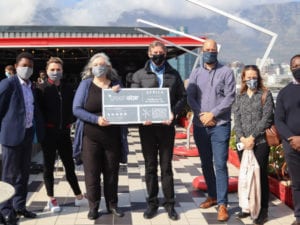The V&A Waterfront has achieved another sustainability accolade, the Green Buildings Council of South Africa (GBCSA) handed over a plaque recognising the sustainable development of the Silo District’s No. 6 Silo building.
The building, which now houses the new-concept 252 room Radisson RED Hotel, won the award for the Best ‘Other’ Development making it the first new hotel to receive a 5-Star Green Custom Hotel Design rating. It has also received a 5-Star Green Hotel As-Built rating. The Green Star is a points-based green building rating system that evaluates buildings according to global best practice in sustainability. The system allocates points across nine categories including management, indoor environmental quality, energy, transport, innovation and water, materials used, land use and ecology and emissions. As no Green Star existed for hotels, a customised tool was developed for the project. Handing over the plaque to the V&A Waterfront, GBCSA head of technical Georgina Smit, said, “Congratulations to the V&A for pioneering leadership within the hospitality sector. When No. 6 Silo was conceptualised, there was no locally available green building certification tool for hotels. The V&A’s ambitious commitment to green, however, resulted in the project initiating the first Custom Hotel tool to be developed in South Africa, by making use of the GBCSA Custom Tool process. “The GBCSA acknowledge the role that the hospitality sector plays in raising awareness about sustainability and how travellers are increasingly requesting accommodation and transport options that reduce their carbon footprint. No 6 Silo is an example of a green hotel that connects guests to alternative city transport options, precinct scale services that optimise efficiency (such as the innovative central seawater cooling plant) and attention to detail when it comes to dematerialisation in the interior finishes.” The award is one of several awarded to the V&A Waterfront’s Silo district for the property’s ongoing environmental developmental programme to promote green business practices as a strategic focus point throughout the property.Explaining the V&A Waterfront’s sustainability philosophy, Vusi Nondo, Executive Manager for Development said, “We value this latest accolade and all that it signifies as our buildings are an important asset to the V&A Waterfront and we take pride in applying a rigorous approach to sustainable development. As a business we are pragmatic and commercial, but it is also our responsibility to ensure that the legacy we build today does not negatively impact on the future.
“We take a holistic approach to sustainability, and this was the key principle behind our developments at the Silo District, and elsewhere in our developments. Every element of new developments are scrutinised to maximise the efficiency of the design and the operation of the buildings.” A number of sustainable elements were considered The surrounding industrial and warehouse setting of the working harbour and the Zeitz Museum of Contemporary Arts Africa (MOCAA) has been articulated in the design of the building. Concrete and face brick therefore form an integral part of the architecture, giving the hotel a contemporary aesthetic look and ensuring low maintenance. The building is spatially efficient with low VOC finishes. Good levels of natural lighting, together with appropriately designed facades, ensure maximum efficiency of resources. An independent Commissioning Agent was appointed to manage the commissioning and tuning process, which ensures optimum operations of the building. The opportunity to install district-wide services for the various buildings was identified early in the planning of the Silo District. With major initiatives such as the centralised district sea water cooling and heating plant being among the most high-profile interventions, other simpler initiatives such as the shared potable water and fire sprinkler water tanks cut down on the amount of water required to be stored as well as reducing the space in the car park taken up by multiple individual tanks. Other stand out sustainable features considered by the GBCSA includes:- Efficient water and electrical design to minimise demand
- Durability and maintenance were a key consideration in the design detailing of the building
- The building’s close geographical position to Cape Town’s MyCiti bus service and a secure bicycle parking facility, as well as various amenities within walking distance promotes the use of sustainable public transport








